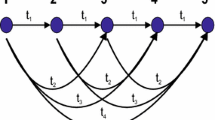Abstract
Let R be a real closed field. An integer part I for R is a discretely ordered subring such that for every \({r \in R}\) , there exists an \({i \in I}\) so that i ≤ r < i + 1. Mourgues and Ressayre (J Symb Logic 58:641–647, 1993) showed that every real closed field has an integer part. The procedure of Mourgues and Ressayre appears to be quite complicated. We would like to know whether there is a simple procedure, yielding an integer part that is \({\Delta^0_2(R)}\) —limit computable relative to R. We show that there is a maximal Z-ring \({I \subseteq R}\) which is \({\Delta^0_2(R)}\) . However, this I may not be an integer part for R. By a result of Wilkie (Logic Colloquium ’77), any Z-ring can be extended to an integer part for some real closed field. Using Wilkie’s ideas, we produce a real closed field R with a Z-ring \({I \subseteq R}\) such that I does not extend to an integer part for R. For a computable real closed field, we do not know whether there must be an integer part in the class \({\Delta^0_2}\) . We know that certain subclasses of \({\Delta^0_2}\) are not sufficient. We show that for each \({n \in \omega}\) , there is a computable real closed field with no n-c.e. integer part. In fact, there is a computable real closed field with no n-c.e. integer part for any n.
Similar content being viewed by others
References
Asatryan, G.: On ordered fields with infinitely many integer parts, preprint (2008)
Ash C.J., Knight J.F.: Computable Structures and the Hyperarithmetical Hierarchy, Stud. Logic Found. Math, vol. 144. Elsevier, Amsterdam (2000)
Berarducci A., Otero M.: A recursive nonstandard model of normal Open induction. J. Symb. Logic 61, 1228–1241 (1996)
D’Aquino P., Knight J.F., Starchenko S.: Real closed fields and models of Peano arithmetic. J. Symb. Logic 75, 1–11 (2010)
Ershov, Yu.: A certain hierarchy of sets I, II, III, algebra and Logic, #1, vol. 7, pp. 47–74 (1968); #4, vol. 7, pp.15–47 (1968); #1, vol. 9, pp. 34–51 (1970)
Knight, J.F., Lange, K.: Countable real closed fields and developments of bounded length. preprint (2011)
Kuhlmann S.: Ordered Exponential Fields, Fields Insititute Monographs. AMS, Providence, RI (2000)
Moniri M., Moniri M.: Some weak fragments of HA and certain closure properties. J. Symb. Log 67, 91–103 (2002)
Mourgues M.H., Ressayre J.-P.: Every real closed field has an integer part. J. Symb. Logic 58, 641–647 (1993)
Shepherdson J.: A non-standard model for the free variable fragment of number theory. Bulletin de l’Academie Polonaise Des Sciences 12, 79–86 (1964)
Tarski, A.: A decision method for elementary algebra and geometry, US Air Force Project Rand Report R-109, (1948). Republished: Tarski, A. A Decision Method for Elementary Algebra and Geometry, 2nd edn., University of California Press, (1951)
Wilkie, A.: Some results and problems on weak systems of arithmetic. In: Logic Colloquium ’77. North Holland (1978)
Author information
Authors and Affiliations
Corresponding author
Additional information
An erratum to this article is available at http://dx.doi.org/10.1007/s00153-015-0418-y.
Rights and permissions
About this article
Cite this article
D’Aquino, P., Knight, J. & Lange, K. Limit computable integer parts. Arch. Math. Logic 50, 681–695 (2011). https://doi.org/10.1007/s00153-011-0241-z
Received:
Accepted:
Published:
Issue Date:
DOI: https://doi.org/10.1007/s00153-011-0241-z



